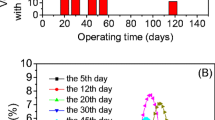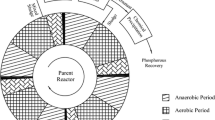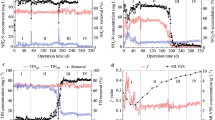Abstract
Partial nitritation is necessary for the implementation of the mainstream anammox (anaerobic ammonium oxidation) process in wastewater treatment plants. However, the difficulty in outcompeting nitrite-oxidizing bacteria (NOB) at mainstream conditions hinders the performance of partial nitritation. The present work aimed to develop a high-rate partial nitritation process for low-ammonium wastewater treatment at low temperatures by seeding aerobic granules. Experimental results suggested that both stratified structure of nitrifiers developed in the granules and sufficient residual ammonium concentration (18–35 mg N L−1) in the bulk liquid contributed to efficient NOB repression. With the hydraulic retention time progressively shortened from 1.0 to 0.17 h, the influent nitrogen loading rate of the partial nitritation process reached 6.8 ± 0.4 kg N m−3 d−1 even at 10–15 °C. The high concentration (7.5 gVSS L−1) and activity (0.48 g N g−1 VSS d−1 at 11 °C) of granular sludge made the reactor possess an overcapacity evaluated by the ratio between the actual ammonium oxidation rate of the granules and their maximum potential. The overcapacity helped the reactor to face the adverse effect of decreasing temperatures. Overall, this work indicated the great potential of applying aerobic granules to achieve high-rate partial nitritation at mainstream conditions. Moreover, anammox bacteria with a relative abundance of 2.8% was also identified in the partial nitritation granules at the end of this study, suggesting that the granules provided a habitable niche for anammox bacteria growth. Note that these results cannot fully relate to the treatment of real domestic/municipal wastewater, they are a source of important information increasing the knowledge about low temperature partial nitrification.
Graphical abstract








Similar content being viewed by others
References
Agrawal S, Seuntjens D, Cocker P, Lackner S, Vlaeminck SE (2018) Success of mainstream partial nitritation/anammox demands integration of engineering, microbiome and modeling insights. Curr Opin Biotechnol 50:214–221. https://doi.org/10.1016/j.copbio.2018.01.013
APHA (2005) Standard methods for the examination for water and wastewater american public health association, 21st edn. American Public Health Association, Washington, DC
Bartroli A, Perez J, Carrera J (2010) Applying ratio control in a continuous granular reactor to achieve full nitritation under stable operating conditions. Environ Sci Technol 44:8930–8935. https://doi.org/10.1021/es1019405
Bian W et al (2017) Achieving nitritation in a continuous moving bed biofilm reactor at different temperatures through ratio control. Bioresour Technol 226:73–79. https://doi.org/10.1016/j.biortech.2016.12.014
Cao Y, van Loosdrecht MCM, Daigger GT (2017) Mainstream partial nitritation-anammox in municipal wastewater treatment: status, bottlenecks, and further studies. Appl Microbiol Biotechnol 101:1365–1383. https://doi.org/10.1007/s00253-016-8058-7
Delgado Vela J, Stadler LB, Martin KJ, Raskin L, Bott CB, Love NG (2015) Prospects for biological nitrogen removal from anaerobic effluents during mainstream wastewater treatment. Environ Sci Tech Let 2(9):234–244. https://doi.org/10.1021/acs.estlett.5b00191
Duan H, Ye L, Lu X, Yuan Z (2019) Overcoming nitrite oxidizing bacteria adaptation through alternating sludge treatment with free nitrous acid and free ammonia. Environ Sci Technol 53:1937–1946. https://doi.org/10.1021/acs.est.8b06148
Ge S, Peng Y, Qiu S, Zhu A, Ren N (2014) Complete nitrogen removal from municipal wastewater via partial nitrification by appropriately alternating anoxic/aerobic conditions in a continuous plug-flow step feed process. Water Res 55:95–105. https://doi.org/10.1016/j.watres.2014.01.058
Gu S, Wang S, Yang Q, Yang P, Peng Y (2012) Start up partial nitrification at low temperature with a real-time control strategy based on blower frequency and pH. Bioresour Technol 112:34–41. https://doi.org/10.1016/j.biortech.2011.12.028
Gu J, Yang Q, Liu Y (2018) Mainstream anammox in a novel A-2B process for energy-efficient municipal wastewater treatment with minimized sludge production. Water Res 138:1–6. https://doi.org/10.1016/j.watres.2018.02.051
Guo Q, Xing BS, Li P, Xu JL, Yang CC, Jin RC (2015) Anaerobic ammonium oxidation (anammox) under realistic seasonal temperature variations: characteristics of biogranules and process performance. Bioresour Technol 192:765–773. https://doi.org/10.1016/j.biortech.2015.06.049
Gustavsson DJI, Suarez C, Wilén BM, Hermansson M, Persson F (2020) Long-term stability of partial nitritation-anammox for treatment of municipal wastewater in a moving bed biofilm reactor pilot system. Sci Total Environ 714:136342. https://doi.org/10.1016/j.scitotenv.2019.136342
Haaksman VA, Mirghorayshi M, van Loosdrecht MCM, Pronk M (2020) Impact of aerobic availability of readily biodegradable COD on morphological stability of aerobic granular sludge. Water Res 187:116402. https://doi.org/10.1016/j.watres.2020.116402
Isanta E, Reino C, Carrera J, Perez J (2015) Stable partial nitritation for low-strength wastewater at low temperature in an aerobic granular reactor. Water Res 80:149–158. https://doi.org/10.1016/j.watres.2015.04.028
Ivanov V, Wang XH, Tay STL, Tay JH (2006) Bioaugmentation and enhanced formation of microbial granules used in aerobic wastewater treatment. Appl Microbiol Biotechnol 70(3):374–381. https://doi.org/10.1007/s00253-005-0088-5
Jemaat Z, Bartroli A, Isanta E, Carrera J, Suarez-Ojeda ME, Perez J (2013) Closed-loop control of ammonium concentration in nitritation: convenient for reactor operation but also for modeling. Bioresour Technol 128:655–663. https://doi.org/10.1016/j.biortech.2012.10.045
Jin P, Li B, Mu D, Li X, Peng Y (2019) High-efficient nitrogen removal from municipal wastewater via two-stage nitritation/anammox process: long-term stability assessment and mechanism analysis. Bioresour Technol 271:150–158. https://doi.org/10.1016/j.biortech.2018.09.097
Kartal B, Kuenen J, Van Loosdrecht M (2010) Sewage treatment with anammox. Science 328:702–703. https://doi.org/10.1126/science.1185941
Kouba V, Vejmelkova D, Proksova E, Wiesinger H, Concha M, Dolejs P, Hejnic J, Jenicek P, Bartacek J (2017) High-rate partial nitritation of municipal wastewater after psychrophilic anaerobic pretreatment. Environ Sci Technol 51:11029–11038. https://doi.org/10.1021/acs.est.7b02078
Law YY, Matysik A, Chen XM, Swa-Thi S, Ngoc-Nguyen TQ, Qiu GL, Natarajan G, Williams RBH, Ni BJ, Seviour TW, Wuertz S (2019) High dissolved oxygen selection against Nitrospira sublineage I in full-scale activated sludge. Environ Sci Technol 53:8157–8166. https://doi.org/10.1021/acs.est.9b00955
Liu W, Yang Q, Ma B, Li J, Ma L, Wang S, Peng Y (2017) Rapid achievement of nitritation using aerobic starvation. Environ Sci Technol 51:4001–4008. https://doi.org/10.1021/acs.est.6b04598
Liu WR, Ji XM, Wang JF, Yang DH, Shen TL, Chen CJ, Qian FY, Wu P (2018a) Microbial community response to influent shift and lowering temperature in a two-stage mainstream deammonification process. Bioresour Technol 262:132–140. https://doi.org/10.1016/j.biortech.2018.04.082
Liu WR, Yang D, Shen Y, Wang J (2018b) Two-stage partial nitritation-anammox process for high-rate mainstream deammonification. Appl Microbiol Biotechnol 102:8079–8091. https://doi.org/10.1007/s00253-018-9207-y
Liu WR, Yin F, Yang D (2020) Granules abrasion cause deterioration of nitritation in a mainstream granular sludge reactor with high loading rate. Chemosphere 243:125433. https://doi.org/10.1016/j.chemosphere.2019.125433
Lotti T, Kleerebezem R, Kip CET, Hendrickx TLG, Kruit J, Hoekstra M, van Loosdrecht MCM (2014) Anammox growth on pretreated municipal wastewater. Environ Sci Technol 48:7874–7880. https://doi.org/10.1021/es500632k
Matsumoto S, Katoku M, Saeki G, Terada A, Aoi Y, Tsuneda S, Picioreanu C, van Loosdrecht MC (2010) Microbial community structure in autotrophic nitrifying granules characterized by experimental and simulation analyses. Environ Microbiol 12:192–206. https://doi.org/10.1111/j.1462-2920.2009.02060.x
Pan KL, Gao JF, Fan XY, Li DC, Dai HH (2018) The more important role of archaea than bacteria in nitrification of wastewater treatment plants in cold season despite their numerical relationships. Water Res 145:552–561. https://doi.org/10.1016/j.watres.2018.08.066
Peng L, Xie YK, Van Beeck W, ZhuTytgat WQM, Lebeer S, Vlaeminck SE (2020) Return-sludge treatment with endogenous free nitrous acid limits nitrate production and N2O emission for mainstream partial nitritation/anammox. Environ Sci Technol 54(9):5822–5831. https://doi.org/10.1021/acs.est.9b06404
Pérez J, Lotti T, Kleerebezem R, Picioreanu C, van Loosdrecht MCM (2014) Outcompeting nitrite-oxidizing bacteria in single-stage nitrogen removal in sewage treatment plants: a model-based study. Water Res 66:208–218. https://doi.org/10.1016/j.watres.2014.08.028
Picioreanu C, Perez J, van Loosdrecht MC (2016) Impact of cell cluster size on apparent half-saturation coefficients for oxygen in nitrifying sludge and biofilms. Water Res 106:371–382. https://doi.org/10.1016/j.watres.2016.10.017
Poot V, Hoekstra M, Geleijnse MA, van Loosdrecht MC, Perez J (2016) Effects of the residual ammonium concentration on NOB repression during partial nitritation with granular sludge. Water Res 106:518–530. https://doi.org/10.1016/j.watres.2016.10.028
Qian F, Wang J, Shen Y, Wang Y, Wang S, Chen X (2017) Achieving high performance completely autotrophic nitrogen removal in a continuous granular sludge reactor. Biochem Eng J 118:97–104. https://doi.org/10.1016/j.bej.2016.11.017
Rahman A, Meerburg FA, Ravadagundhi S, Wett B, Jimenez J, Bott C, Al-Omari A, Riffat R, Murthy S, De Clippeleir H (2016) Bioflocculation management through high-rate contact-stabilization: a promising technology to recover organic carbon from low-strength wastewater. Water Res 104:485–496. https://doi.org/10.1016/j.watres.2016.08.047
Regmi P, Miller MW, Holgate B, Bunce R, Park H, Chandran K, Wett B, Murthy S, Bott CB (2014) Control of aeration, aerobic SRT and COD input for mainstream nitritation/denitritation. Water Res 57:162–171. https://doi.org/10.1016/j.watres.2014.03.035
Reino C, Suarez-Ojeda ME, Perez J, Carrera J (2016) Kinetic and microbiological characterization of aerobic granules performing partial nitritation of a low-strength wastewater at 10 degrees C. Water Res 101:147–156. https://doi.org/10.1016/j.watres.2016.05.059
Reino C, Suárez-Ojeda ME, Pérez J, Carrera J (2018) Stable long-term operation of an upflow anammox sludge bed reactor at mainstream conditions. Water Res 128:331–340. https://doi.org/10.1016/j.watres.2017.10.058
Schaubroeck T, De Clippeleir H, Weissenbacher N, Dewulf J, Boeckx P, Vlaeminck SE, Wett B (2015) Environmental sustainability of an energy self-sufficient sewage treatment plant: Improvements through DEMON and co-digestion. Water Res 74:166–179. https://doi.org/10.1016/j.watres.2015.02.013
Seuntjens D, Van Tendeloo M, Chatzigiannidou I, Carvajal-Arroyo JM, Vandendriessche S, Vlaeminck SE, Boon N (2018) Synergistic exposure of return-sludge to anaerobic starvation, sulfide, and free ammonia to suppress nitrite oxidizing bacteria. Environ Sci Technol 52:8725–8732. https://doi.org/10.1021/acs.est.7b06591
Soler-Jofra A, Wang R, Kleerebezem R, van Loosdrecht MCM, Pérez J (2019) Stratification of nitrifier guilds in granular sludge in relation to nitritation. Water Res 148:479–491. https://doi.org/10.1016/j.watres.2018.10.064
Torà JA, Lafuente J, Garcia-Belinchón C, Bouchy L, Carrera J, Baeza JA (2014) High-throughput nitritation of reject water with a novel ammonium control loop: Stable effluent generation for anammox or heterotrophic denitritation. Chem Eng J 243:265–271. https://doi.org/10.1016/j.cej.2013.11.056
Wang L, Zheng P, Chen TT (2012) Performance of autotrophic nitrogen removal in the granular sludge bed reactor. Bioresour Technol 123:78–85. https://doi.org/10.1016/j.biortech.2012.07.112
Wang Q, Ye L, Jiang G, Hu S, Yuan Z (2014) Side-stream sludge treatment using free nitrous acid selectively eliminates nitrite oxidizing bacteria and achieves the nitrite pathway. Water Res 55:245–255. https://doi.org/10.1016/j.watres.2014.02.029
Wang Q, Duan H, Wei W, Ni BJ, Laloo A, Yuan Z (2017) Achieving stable mainstream nitrogen removal via the nitrite pathway by sludge treatment using free ammonia. Environ Sci Technol. https://doi.org/10.1021/acs.est.7b02776
Wang ZH, Peng YZ, Li JW, Liu JJ, Zhang Q, Li XY, Zhang L (2021) Rapid initiation and stable maintenance of municipal wastewater nitritation during the continuous flow anaerobic/oxic process with an ultra-low sludge retention time. Water Res 197:117091. https://doi.org/10.1016/j.watres.2021.117091
Winkler MKH, Straka L (2019) New directions in biological nitrogen removal and recovery from wastewater. Curr Opin Biotechnol 57:50–55. https://doi.org/10.1016/j.copbio.2018.12.007
Winkler MK, Kleerebezem R, Kuenen JG, Yang J, van Loosdrecht MC (2011) Segregation of biomass in cyclic anaerobic/aerobic granular sludge allows the enrichment of anaerobic ammonium oxidizing bacteria at low temperatures. Environ Sci Technol 45:7330–7337. https://doi.org/10.1021/es201388t
Wu J, He C, van Loosdrecht MCM, Pérez J (2016) Selection of ammonium oxidizing bacteria (AOB) over nitrite oxidizing bacteria (NOB) based on conversion rates. Chem Eng J 304:953–961. https://doi.org/10.1016/j.cej.2016.07.019
You J, Das A, Dolan EM, Hu ZQ (2009) Ammonia-oxidizing archaea involved in nitrogen removal. Water Res 43(7):1801–1809. https://doi.org/10.1016/j.watres.2009.01.016
Acknowledgements
This research was supported by the National Natural Science Foundation of China (No. 51808367), and the National & Local Joint Engineering Laboratory for Municipal Sewage Resource Utilization Technology, Suzhou University of Science and Technology (No. 2018KF05). The authors also acknowledge support from the Jiangsu Key Laboratory of Environmental Science and Engineering, and the Jiangsu Collaborative Innovation Center of Technology and Material of Water Treatment.
Author information
Authors and Affiliations
Corresponding author
Ethics declarations
Conflict of interest
All authors declare that they have no conflict of interest. The authors declare that they have no known competing financial interests or personal relationships that could have appeared to influence the work reported in this paper. The authors declare the following financial interests/personal relationships which may be considered as potential competing interests: Wenru Liu, Yaoliang Shen, Dianhai Yang.
Additional information
Publisher's Note
Springer Nature remains neutral with regard to jurisdictional claims in published maps and institutional affiliations.
Rights and permissions
About this article
Cite this article
Liu, W., Shen, Y. & Yang, D. Achieving high-rate partial nitritation with aerobic granular sludge at low temperatures. Biodegradation 33, 45–58 (2022). https://doi.org/10.1007/s10532-021-09965-8
Received:
Accepted:
Published:
Issue Date:
DOI: https://doi.org/10.1007/s10532-021-09965-8




